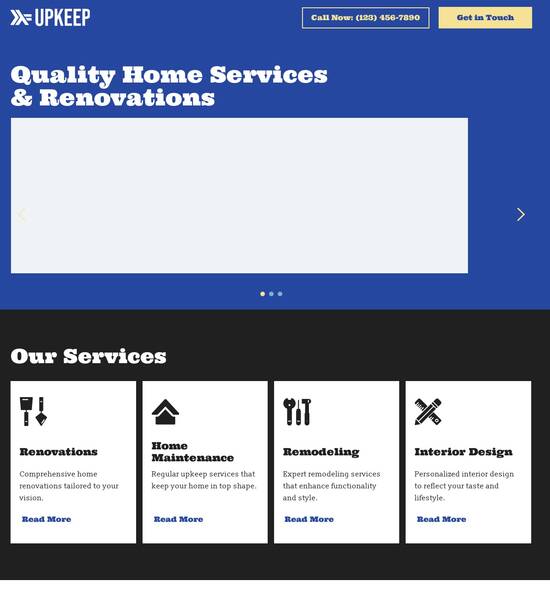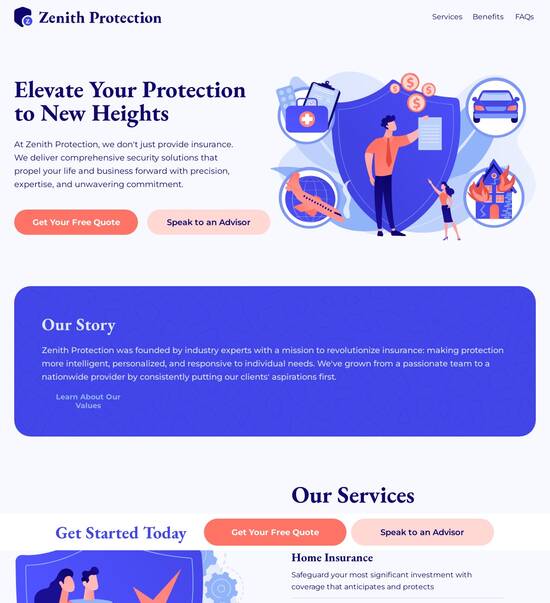
Next.js optimized music streaming website template
Explore Similar TemplatesAbout template
Leverage our intuitive page builder and high-converting Next.js optimized music streaming website template.
Recommended templates

Easy to build without coding
With the intuitive drag-and-drop builder, anyone on your team can create high-converting pages without any knowledge of code or design. Make enhancements to your landing page with custom widgets using Javascript, HTML/CSS, or third-party scripts.

Multiple layouts for any industry and goal
Select from 500+ landing page layouts built to boost conversions across industry-specific scenarios. Customize them by adjusting fonts, adding images, and generating on-brand content with the AI assistant. Quickly scale with Instablocks® and Global Blocks that you can save, reuse, and update globally.

Loads fast and looks polished on any device
Every template is responsive, which means they present professionally on any device and load blazingly fast with our Thor Render Engine. You can also power them up with Google AMP technology to deliver an unparalleled mobile experience and drive higher conversions.

Robust analytics & experimentation
Get real-time updates and reporting across all your devices, showing the number of visitors, conversions, cost-per-visitor, and cost-per-lead. Launch AI-powered experiments, run A/B tests, and use heatmaps to analyze user behavior, then optimize your landing page to maximize conversions.







Easy to build without coding
With the intuitive drag-and-drop builder, anyone on your team can create high-converting pages without any knowledge of code or design. Make enhancements to your landing page with custom widgets using Javascript, HTML/CSS, or third-party scripts.
Multiple layouts for any industry and goal
Select from 500+ landing page layouts built to boost conversions across industry-specific scenarios. Customize them by adjusting fonts, adding images, and generating on-brand content with the AI assistant. Quickly scale with Instablocks® and Global Blocks that you can save, reuse, and update globally.
Loads fast and looks polished on any device
Every template is responsive, which means they present professionally on any device and load blazingly fast with our Thor Render Engine.
Robust analytics & experimentation
Get real-time updates and reporting across all your devices, showing the number of visitors, conversions, cost-per-visitor, and cost-per-lead. Launch AI-powered experiments, run A/B tests, and use heatmaps to analyze user behavior, then optimize your landing page to maximize conversions.
All the features you need to build lead-generating landing pages
Explore more featuresLearn how to build top-performing landing pages for any goal
FAQs
Leading the way in building high-performing landing pages





An all-in-one landing page and CRO platform for marketers
In the competitive landscape of digital marketing, having an effective landing page can significantly influence your campaign success. Instapage stands out as a powerful tool, designed specifically for marketing professionals aiming to enhance and optimize their conversion rates. This step-by-step guide is tailored to demonstrate how marketers can leverage Instapage's unique features to maximize their digital marketing ROI.
Understanding the power of Instapage
Instapage is more than just a landing page builder; it’s a comprehensive Conversion Rate Optimization (CRO) platform. Its robust features allow users to create high-quality landing pages that are quick to deploy, optimized for performance, and customized for specific audience needs. Here’s how you can harness the full potential of Instapage to drive results.
- 100+ high-converting templates: Save time with ready-to-use designs that are proven to capture leads.
- Intuitive page builders: No coding required; simply drag and drop elements to create your ideal layout.
- Built-in A/B testing: Experiment with variations of your landing pages to identify what resonates best with your audience.
Step 1: Create your landing page
Getting started with Instapage is straightforward. First, sign up for an account and select a template that best aligns with your campaign objective. Utilize the intuitive drag-and-drop interface to add images, text, and forms, ensuring that each element is geared towards enhancing user engagement.
Step 2: Optimize for conversion
Once your landing page is set up, focus on optimization strategies. Use Instapage's built-in heatmaps to observe user behavior on your page, allowing you to make informed decisions as you adjust content to enhance engagement.
- Conduct A/B testing: Experiment with different headlines and CTA buttons to find the most effective combination.
- Leverage personalization: Use dynamic text replacement to create relevant experiences for different audiences.
- Monitor performance metrics: Use Instapage’s analytics dashboard to track key KPIs and identify areas for improvement.
Step 3: Collaborate and review
Collaboration is key to successful campaign execution. Instapage offers features that allow team members to provide instant feedback and make real-time edits. This function not only saves time but ensures that your landing pages are polished and perfect before launch.
- Real-time editing features: Enhance productivity by allowing team members to collaborate synchronously.
- Easy sharing options: Securely share your pages with stakeholders or clients to gather input and make adjustments based on their feedback.
- Version control: Keep track of all changes made to optimize your workflows and streamline revisions.
By following these steps, marketers can efficiently develop landing pages that are not only appealing but truly optimized for conversion. Through the streamlined processes available in Instapage, you can significantly boost your campaign's effectiveness and ensure a higher return on investment.
Ready to take your marketing efforts to the next level? Explore how Instapage can transform your landing page strategy and drive measurable results. Start your free trial today!
Unleashing the Power of Next.js: Crafting a Cutting-Edge Music Streaming Website Template
The Next.js advantage: Why choose a Next.js template for music streaming
When considering a template for a music streaming website, Next.js stands out due to its robust features tailored for high-performance web applications. As a hybrid framework, Next.js combines the best of server-side rendering (SSR) and static site generation (SSG), resulting in faster load times and improved SEO. This means users enjoy seamless access to music content without frustrating delays, enhancing their overall experience.
Moreover, Next.js seamlessly integrates with React, allowing developers to leverage a component-based design for easy management and reuse of code. This leads to a more organized codebase and expedites the development process. Features like hot reloading and simplified debugging mechanisms also streamline the workflow, reducing friction during both development and maintenance.
Performance optimizations through server-side rendering for rapid load times.
Static site generation benefits for scalability and improved user experience.
Key features of a Next.js music streaming template
A well-designed music streaming template using Next.js can offer an array of key features that significantly enhance user interaction. One of the most critical components is dynamic routing and URL management. This functionality provides users with an intuitive browsing experience, allowing them to access artists, albums, or playlists through clean, well-structured URLs that are easy to navigate. Proper URL structure not only benefits users but also improves search engine indexing, making the site more discoverable.
Media handling capabilities are another vital aspect; Next.js allows for native audio and video player integration, giving users a seamless playback experience. By optimizing the delivery of media content through a content delivery network (CDN), the template can ensure that users enjoy smooth streaming without buffering. This integration is crucial for maintaining user engagement in a competitive music streaming landscape.
Dynamic routing enhances user experience by simplifying site navigation.
Native audio and video player integration for seamless playback.
CDN optimizations for faster media serving.
Tailoring your music streaming experience with Next.js templates
Customization is crucial for delivering a unique music streaming experience. Next.js templates allow developers to create layouts and components that are responsive and optimized for mobile devices. Given that a significant portion of music consumption occurs on smartphones and tablets, prioritizing a mobile-first approach can greatly enhance user satisfaction. Furthermore, creating modular components for various elements such as artist profiles, playlists, and albums simplifies the development process and fosters a coherent, attractive design.
Additionally, integrating user interaction features such as advanced search and filtering mechanisms can drive engagement. These features enable users to quickly find specific tracks, artists, or genres, significantly enhancing the overall user experience. Social sharing capabilities can further improve community engagement, allowing users to share their favorite music with ease across various platforms.
Utilizing responsive design principles for mobile-first projects.
Exploring modular components for artist profiles, playlists, and albums.
The development process: Building your Next.js music streaming template
Establishing a strong development environment is fundamental before creating your music streaming template. Essential tools and libraries, such as Node.js, React, and various Next.js plugins, provide an optimized framework for the development process. In addition, setting up your workspace effectively will enhance productivity—be sure to include version control systems like Git to manage code changes easily and collaborate with other developers.
When creating the music streaming template from scratch, it’s essential to plan your pages and components for scalability. Structuring your application in a way that accommodates future growth can save significant time and resources later. Integrating APIs for real-time data loading ensures that the music catalog stays current with minimal delays, thereby maintaining user engagement.
Setting up essential tools and libraries for Next.js development.
Structuring pages and components with scalability in mind.
Automated testing practices for performance assurance.
Ability to scale: The future of your music streaming template
Building a music streaming template with Next.js is not just about creating a functional application; it's equally important to ensure it can scale as your user base grows. Leveraging a microservices architecture allows your app to handle increased user loads efficiently. This approach ensures that various music streaming functions can operate independently, minimizing the risk of downtime during peak traffic.
Additionally, preparing for a global audience through internationalization (i18n) support makes your application more inclusive. This feature allows you to offer translations and localized content, catering to users from diverse linguistic backgrounds. Implementing real-time features, such as integrating WebSocket for live updates, keeps users informed about new music releases or events, thereby enhancing engagement.
Leveraging microservices architecture to manage increasing user load.
Preparing for global users with internationalization (i18n) support.
Admin template integration: Simplifying management overhead
An efficient admin dashboard is essential for managing a music streaming platform effectively. Key features to consider for operational efficiency include content management tools, user analytics, and reporting capabilities. Ensuring that admins can easily curate playlists and manage releases is fundamental for keeping the platform fresh and engaging for users. Integrating analytics provides insights into user behavior and engagement, which can profoundly influence content strategies.
By employing best practices for maintaining content freshness, you can regularly update offerings to reflect current trends in music. This involves not only curating playlists based on user preferences but also responding swiftly to emerging artists and genres. Strategies for leveraging social media insights can help in this curation process, ensuring your platform remains relevant and appealing.
Key features for operational efficiency in an admin dashboard.
Best practices for curating playlists and managing new releases.
The role of documentation in the development workflow
Clear and comprehensive documentation is essential for any development project. It serves as a reference for developers and contributes to a smoother collaboration process. Maintaining accessible documentation ensures that onboarding new team members takes less time, allowing them to understand the codebase and template features quickly. Utilizing tools like Storybook can facilitate the documentation of components effectively, ensuring that each part of your system is well understood.
Engaging with the Next.js community can also provide significant support resources. Active forums, GitHub discussions, and community documentation serve as valuable tools for troubleshooting and learning. Sharing your experiences can foster collaboration, helping to enhance the overall quality of the templates developed within the ecosystem.
Importance of maintaining clear, accessible documentation.
Engaging with the Next.js community for support resources.
Exploring the benefits of a Next.js music streaming template
Employing a Next.js template for your music streaming website can lead to exceptional performance and SEO optimization. With built-in SEO capabilities, it's easier to improve search rankings, which is crucial in a saturated industry. The framework's automatic code splitting and optimized loading can significantly enhance page speed, a key factor in retaining users and improving conversion rates.
Furthermore, utilizing open-source components within the template can lead to substantial cost savings during development. This not only reduces time spent on coding from scratch but also enhances customization options for features that are unique to your platform. By streamlining the development process, teams can focus on creating innovative user experiences rather than addressing foundational issues.
Improving search rankings with built-in SEO capabilities.
Cost-effective development through the use of open-source components.
Embracing RTL support in music streaming templates
Support for right-to-left (RTL) languages in music streaming templates is essential for serving a diverse audience. Understanding the importance of bi-directional support allows developers to create inclusive experiences for users whose primary languages are read in RTL formats. By implementing best practices for RTL layouts in Next.js, developers can ensure that their applications are accessible to a wider range of users.
There are several successful music streaming platforms that have incorporated RTL features effectively. Analyzing these platforms can provide valuable insights into how to implement RTL support, including changes in layout, text direction, and user interface components to enhance usability for RTL speakers.
Importance of bi-directional support for diverse audiences.
Highlighting existing platforms that have embraced RTL features.
Shaping user journeys: Crafting engaging landing pages with Next.js
Landing pages serve as the first point of contact with potential users, making their design pivotal. Crafting high-converting landing pages requires attention to key elements that encourage user engagement and conversions. These can include visually appealing designs, clear calls to action, and concise information about music offerings.
Implementing A/B testing strategies allows you to monitor user interactions and optimize the landing page based on real-time data. By analyzing metrics like click-through rates and user behavior, you can make informed decisions that lead to improved user engagement. In addition, integrating marketing tools into your Next.js templates provides further opportunities for data-driven decision-making, enhancing overall marketing effectiveness and user onboarding.
Key elements that drive user engagement and conversions.
How to link analytics tools for data-driven decision making.
Final thoughts: The evolution of music streaming through Next.js
The transformative potential of Next.js templates within the music streaming industry cannot be overstated. By leveraging the unique capabilities of Next.js, developers can create highly optimized websites that cater to evolving user expectations. From performance enhancements to user engagement features, these templates are set to revolutionize the way music is streamed and experienced online. As technology continues to evolve, Next.js stands as a robust foundation, empowering developers to build innovative solutions that enhance user engagement and foster community within the music streaming space.
Ready to skyrocket conversions?
Supercharge your ad campaigns with high-performing landing pages
Get started














